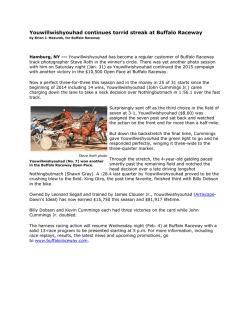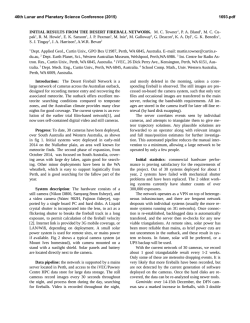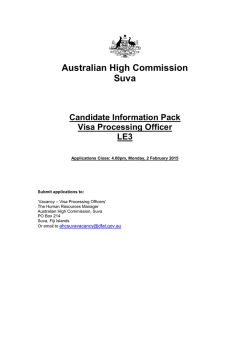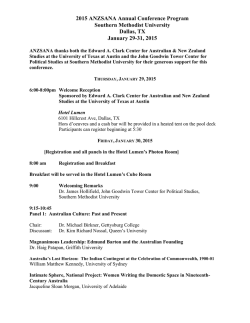
Wolbachia infection in Australasian and North
Veterinary Parasitology 162 (2009) 350–353 Contents lists available at ScienceDirect Veterinary Parasitology journal homepage: www.elsevier.com/locate/vetpar Short communication Wolbachia infection in Australasian and North American populations of Haematobia irritans (Diptera: Muscidae) Bing Zhang a, Elizabeth McGraw b, Kevin D. Floate c, Peter James a,*, Wayne Jorgensen a, Jim Rothwell d a Animal Research Institute, Department of Primary Industries and Fisheries, Brisbane, Australia School of Integrative Biology, University of Queensland, Brisbane, Australia Lethbridge Research Centre, Agriculture and Agri-Food Canada, Lethbridge, Alberta, Canada, T1J 4B1 d School of Veterinary Science, University of Queensland, Brisbane, Australia b c A R T I C L E I N F O A B S T R A C T Article history: Received 20 December 2008 Received in revised form 19 February 2009 Accepted 2 March 2009 Buffalo fly (Haematobia irritans exigua) is a major pest of beef and dairy cattle in northern Australia. Global warming is expected to increase the southern range of buffalo fly. Chemical control is compromised by resistance and may not be feasible in extensive production systems and there is rapidly growing market preference for beef and dairy products produced in low-chemical systems. Wolbachia are vertically transmitted intracellular bacteria that can profoundly influence host reproduction and fitness and are of increasing interest for use in biocontrol programs. To determine whether Australian flies are infected with Wolbachia, buffalo flies were collected from 12 cattle herds around Australia and assayed by standard PCR for the Wolbachia wsp gene. H. i. exigua from Indonesia and horn fly (H. i. irritans) from Canada were also tested. All H. i. exigua samples tested were negative for Wolbachia infection whereas a very strong signal for Wolbachia was obtained from H. i. irritans. Crown Copyright ß 2009 Published by Elsevier B.V. All rights reserved. Keywords: Haematobia irritans Wolbachia Diptera 1. Introduction Buffalo fly (Haematobia irritans exigua De Meijere) is one of the main health problems of cattle in northern Australia, recently estimated to cost the beef industry $78 m annually (Sackett et al., 2006). In dairy cattle, infestations above a threshold of 30 flies were estimated to cause losses in milk production and live weight gain of 2.6 ml and 0.14 g per fly per day, respectively (Jonsson and Mayer, 1999). Buffalo fly was introduced into the Northern Territory in 1838 from Indonesia (Williams et al., 1985). Flies spread south from Bundaberg in Queensland to Coffs Harbour in NSW between 1974 and 1982, partly in response to a series * Corresponding author at: Department of Primary Industries and Fisheries, Locked Mail Bag No. 4 Moorooka, 4105 Qld, Australia. Tel.: +61 7 3362 9409; fax: +61 7 3362 9429. E-mail address: [email protected] (P. James). of mild winters (Williams et al., 1985). Ongoing climate change is expected to lead to increasing wetness in northern Australia and increasing temperatures in southern Australia (White et al., 2003), which will increase the range of buffalo fly and numbers of cattle exposed to the pest. Buffalo fly has traditionally been controlled mainly by the application of pesticides, although fly populations are moderated by dung beetle activity and buffalo flytraps can also be used. However, resistance has reduced the effectiveness of chemical controls (Farnsworth et al., 1997), there are human and environmental health issues associated with widespread use of insecticides and there is growing market preference for beef and dairy products produced in low-chemical systems. Wolbachia (Rickettsiales: Rickettsaceae) are obligate, intracellular bacteria found naturally in many arthropods and some filarial nematodes (e.g. Floate et al., 2006). They are able to rapidly invade and establish in insect populations 0304-4017/$ – see front matter . Crown Copyright ß 2009 Published by Elsevier B.V. All rights reserved. doi:10.1016/j.vetpar.2009.03.012 B. Zhang et al. / Veterinary Parasitology 162 (2009) 350–353 through effects such as cytoplasmic incompatibility, feminization of males, male killing and induction of parthenogenesis (Stouthamer et al., 1999). Their wide-ranging effects on reproduction and host fitness have made Wolbachia the subject of growing interest as potential biocontrol agents (Werren and O’Neill, 1997; Zabalou et al., 2004; Floate et al., 2006; Bourtzis, 2008). Such interest has led to testing for Wolbachia in horn fly (Haematobia irritans irritans (L.)). Horn fly, very closely related to buffalo fly, is a major pest of cattle in the Americas, Europe and northern Asia. To date, all populations of horn fly tested have been positive for Wolbachia (Jeyaprakash and Hoy, 2000; Floate et al., 2006), which suggests that infections may also be present in the buffalo fly. However, surveys of buffalo fly populations have not been previously performed. Here, we report the results of the first survey for Wolbachia in buffalo flies. Results will facilitate future research on the potential use of these bacteria for use in buffalo fly biocontrol programs. 2. Materials and methods 2.1. Fly sample collection Buffalo flies were collected from 12 locations in Australia (Fig. 1) and from Bali, Indonesia. A total of 134 buffalo flies, 127 from Australia and 7 from Indonesia were tested. Specimens were immediately stored in 20% DMSO/ 0.25 M EDTA solution (Seutin et al., 1991). Horn flies (N = 70) were collected from three locations in southern Alberta, Canada (Table 1), stored in 95% EtOH and held at 20 8C until tested. 2.2. Tests for Wolbachia Buffalo flies were tested for Wolbachia in laboratories in Australia and Canada with the numbers tested in each laboratory as indicated in Table 1. To confirm the test 351 Fig. 1. Sites of buffalo fly collection in Australia. method, horn flies were also tested in each laboratory (Table 1). In Australia, genomic DNA was extracted from individual flies using Puregene Tissue Core Kits (Qiagen) according to the manufacturer’s instructions. Extracted DNA was tested for the presence of Wolbachia using polymerase chain reaction (PCR) tests and wsp primers. These primers amplify Wolbachia DNA (if present) to detectable levels that can be visualized as bands of characteristic size (ca. 600 bp) on agarose gels (Braig et al., 1998). DNA from a single D. melanogaster known to be infected was used as a positive control. PCR was performed in a 20 ml volume containing 50 mM KCl, 10 mM Tris–HCl (pH 9.0), 2.5 mM MgCl2, 0.1 mM dNTPs, 0.5 mM primers, and 0.8 unit Taq DNA Polymerase (Roche Molecular Biochemicals, Indianapolis, IN). The thermal cycling regime was as follows: 3 min denaturation at 94 8C, 35 cycles of 0.5 min denaturation at 94 8C, 0.5 min annealing at 55 8C and 1 min extension at 72 8C, followed by an extra 10 min extension step at 72 8C. The Table 1 Summary of screening for Wolbachia infection in buffalo flies and horn flies. Species Source Where tested No. flies testing positive Buffalo fly Gatton, Qld Berrimah Farm, NT Douglas Daly, NT Beatrice Hill Farm, NT Australia Australia Australia Australia Canada Australia Australia Canada Australia Australia Australia Australia Canada Australia Australia Australia Canada 0 0 0 0 0 0 0 0 0 0 0 0 0 0 0 0 0 Australia Canada Canada Canada 4 of 5 50 of 50 5 of 5 10 of 10 Yeerongpilly, Qld Mutdapilly, Qld Rochedale, Qld Pinjarra Hills, Qld Duck Creek Research Farm, NSW Warrawagine, WA, Camballin, WA, Ruby Plains, WA, Gianyar, Bali, Indonesia Horn fly Lethbridge Research Centre colony Coaldale, AB Onefour, AB of of of of of of of of of of of of of of of of of 33 8 8 8 2 10 8 4 6 4 8 8 4 8 8 5 2 352 B. Zhang et al. / Veterinary Parasitology 162 (2009) 350–353 Fig. 2. Agarose gel electrophoresis analysis of PCR products: lane 1 = DNA marker; lane 2 = positive control (wsp gene); lane 3–6 = horn fly samples; lane 7–12 = buffalo fly samples. to reduce fitness traits such as survival, locomotion or olfaction to suppress populations, limit dispersal or curtail host-seeking behaviours (Fleury et al., 2000; McGraw et al., 2002) Successful transfection of Wolbachia across genus and species barriers and establishment of stable infections in previously naı¨ve insect populations has been reported (Bourtzis, 2008). Although our studies found no evidence of Wolbachia infection in buffalo fly, the widespread occurrence of Wolbachia in most insect orders and in closely related H. i. irritans suggests that H i. exigua may be a competent host. Further studies are planned to investigate the feasibility of transfection of H. i. exigua with Wolbachia as a basis for novel control approaches. Acknowledgements PCR reaction was run in a Mastercycler (Eppendorf, Westbury, NY, USA). PCR products were separated by agarose gel electrophoresis, and stained with ethidium bromide (Fig. 2). DNA bands of ca. 600 bp were extracted and purified from gels. Sequencing confirmed the presence of Wolbachia. Similar methods were used in Canada, with specific details provided in Kyei-Poku et al. (2003). We acknowledge J. Kidd, L. Small, W. Ehrlich, G. Everingham, P. Freeman, K. Puja, and M. Bullard for collection of buffalo fly samples, and P. Coghlin for collection and testing of horn fly samples in Canada. This work was supported by Department of Primary Industries and Fisheries, Queensland and University of Queensland. 3. Results Bourtzis, K., 2008. Wolbachia-based technologies for insect pest population control. Adv. Exp. Med. Biol. 627, 104–113. Braig, H.R., Zhou, W., Dobson, S.L., O’Neill, S.L., 1998. Cloning and characterization of a gene encoding the major surface protein of the bacterial endosymbiont Wolbachia pipientis. J. Bacteriol. 180 (9), 2373–2378. Brownstein, J.S., Hett, E., O’Neill, S.L., 2003. The potential of virulent Wolbachia to modulate disease transmission by insects. J. Invertebr. Pathol. 84 (1), 24–29. Farnsworth, W.R., Collett, M.G., Ridley, I.S., 1997. Field survey of insecticide resistance in Haematobia irritans exigua de Meijere (Diptera: Muscidae). Aust. J. Entomol. 36, 257–261. Fleury, F., Vavre, F., Ris, N., Fouillet, P., Bouletreau, M., 2000. Physiological cost induced by the maternally transmitted endosymbiont Wolbachia in the Drosophila parasitoid Leptopilina heterotoma. Parasitology 121, 493–500. Floate, K.D., Kyei-poku, G.K., Coghlin, P.C., 2006. Overview and relevance of Wolbachia bacteria in biocontrol research. Biocontrol Sci. Technol. 16, 767–788. Jeyaprakash, A., Hoy, M.A., 2000. Long PCR improves Wolbachia DNA amplification: wsp sequences found in 76% of 63 arthropod species. Insect Mol. Biol. 4, 393–405. Jonsson, N.N., Mayer, D.G., 1999. Estimation of the effects of buffalo fly (Haematobia irritans exigua) on the milk production of dairy cattle based on a meta-analysis of literature data. Med. Vet. Entomol. 13, 372–376. Kyei-Poku, G.K., Floate, K.D., Benkel, B., Goettel, M.S., 2003. Elimination of Wolbachia from Urolepis rufipes (Ashmead) (Hymenoptera: Pteromalidae) with heat and antibiotic treatments: implications for host reproduction. Biocontrol Sci. Technol. 13, 341–354. Kyei-Poku, G.K., Giladi, M., Coghlin, P., Mokady, O., Zchori-Fein, E., Floate, K.D., 2006. Wolbachia in wasps parasitic on filth flies (Diptera: Muscidae) with emphasis on Spalangia cameroni Perkins (Hymenoptera: Pteromalidae). Entomologia Experimentalis et Applicata 121, 123–135. McGraw, E.A., Merritt, D.J., Droller, J.N., O’Neill, S.L., 2002. Wolbachia density and virulence attenuation following transfer into a novel host. Proc. Natl. Acad. Sci. U.S.A. 99, 2918–2923. Sackett, D., Holmes, P., Abbott, K., Jephcott, S., Barber, M., 2006. Assessing the economic cost of endemic disease on the profitability of Australian beef cattle and sheep producers. Final report of project AHW-087 Meat and Livestock Australia, Sydney, pp. 119 (ISBN 1741910021). Seutin, G., White, B.N., Boag, P.T., 1991. Preservation of avian blood and tissue samples for DNA analyses. Can. J. Zool.-Revue Canadienne de Zoologie 69 (1), 82–90. No infections of Wolbachia were detected in buffalo flies. However, Wolbachia were detected in each positive control and in 69 of 70 horn flies individually tested. Results were consistent between laboratories. Previous studies have identified only one isolate of Wolbachia infecting the horn fly (Jeyaprakash and Hoy, 2000; KyeiPoku et al., 2006). 4. Discussion Wolbachia bacteria infect the reproductive cells of an estimated 20–75% of arthropod species (Werren et al., 1995; Jeyaprakash and Hoy, 2000; Werren and Windsor, 2000; Floate et al., 2006), with infections also reported in filarial nematodes (Werren and O’Neill, 1997). Transmission occurs vertically from infected females to their offspring in egg cytoplasm. Although Wolbachia occurs in many Australian insect species and is apparently widespread in North American H. i. irritans populations (Jeyaprakash and Hoy, 2000; Floate et al., 2006) no infections were detected in buffalo flies. Furthermore, the absence of Wolbachia in the sample of H. i. exigua collected from Bali may suggest that this is a more general characteristic of the subspecies. A number of options have been suggested for the use of Wolbachia in insect biocontrol programs. These include the use of cytoplasmic incompatibility induced by Wolbachia to suppress pest populations, as a means of spreading deleterious genes through a target population (Stouthamer et al., 1999; Bourtzis, 2008), to reduce the lifespan of insects and reduce disease transmission (Sinkins and O’Neill, 2000; Brownstein et al., 2003) and References B. Zhang et al. / Veterinary Parasitology 162 (2009) 350–353 Sinkins, S.P., O’Neill, S.L., 2000. Wolbachia as a vehicle to modify insect populations. In: Handler, A.M., James, A.A. (Eds.), Insect Transgenesis: Methods and Applications. CRC Press, Boca Raton, pp. 271– 288. Stouthamer, R., Breeuwer, J.A.J., Hurst, G.D.D., 1999. Wolbachia pipientis: microbial manipulator of arthropod reproduction. Annu. Rev. Microbiol. 53, 71–102. Werren, J.H., Zhang, W., Guo, L.R., 1995. Evolution and phylogeny of Wolbachia: reproductive parasites of arthropods. Proc. Roy. Soc. Lond. Ser. B-Biol. Sci. 251, 55–63. Werren, J.H., O’Neill, S.L., 1997. The evolution of heritable symbionts. In: O’Neill, S.L., Hoffmann, A.A., Werren, J.H. (Eds.), Influential Passengers: Inherited Microorganisms and Arthropod Reproduction. Oxford University Press, Oxford, pp. 1–41. 353 Werren, J.H., Windsor, D.M., 2000. Wolbachia infection frequencies in insects: evidence of a global equilibrium? Proc. Roy. Soc. Lond. Ser. BBiol. Sci. 267, 1277–1285. White, N., Sutherst, R.W., Hall, N., Whish-Wilson, P., 2003. The vulnerability of the Australian beef industry to impacts of the cattle tick (Boophilus microplus) under climate change. Clim. Change 61, 157–190. Williams, J.D., Sutherst, R.W., Maywald, G.F., Petherbridge, C.T., 1985. The southward spread of buffalo fly (Haematobia irritans exigua) in eastern Australia and its survival through a severe winter. Aust. Vet. J. 62, 367–369. Zabalou, S., Riegler, M., Theodorakopoulou, M., Stauffer, C., Savakis, C., Bourtzis, K., 2004. Wolbachia-induced cytoplasmic incompatibility as a means for insect pest population control. Proc. Natl. Acad. Sci. U.S.A. 101 (42), 15042–15045.
© Copyright 2025






